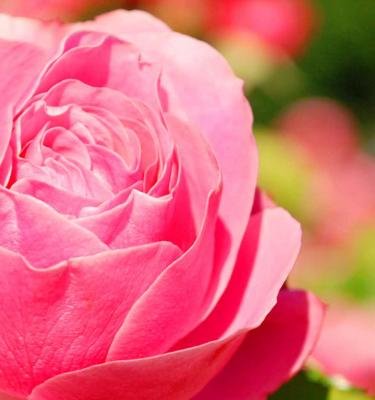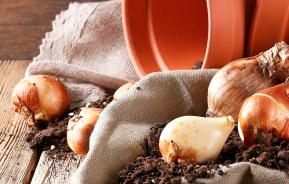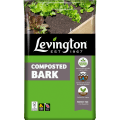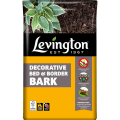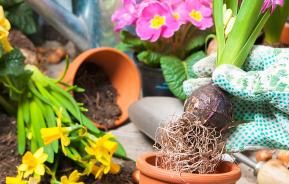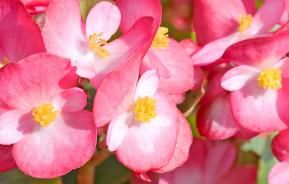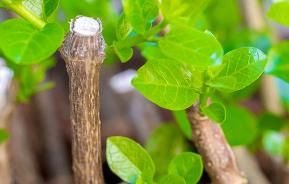Why plant bare-root plants?
Bare-root plants are generally much cheaper than those supplied in containers, as they need less time and effort (and therefore money) spent on their production up to the point of sale. This doesn’t mean they are inferior, it simply means they need less time spent on them watering and feeding as they’re growing in the ground, there’s no cost associated with putting them in a pot with compost and they are lighter and therefore cheaper to transport.
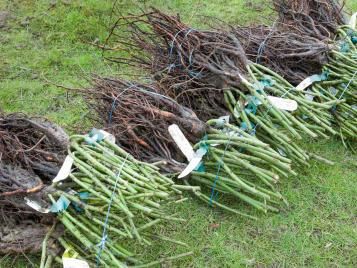
Being lifted from the ground and dispatched when they’re dormant, they’re only available from autumn to the end of February and need to be planted as soon as you receive them – or as soon as possible afterwards.
As well as the price, they also have various advantages over container-grown plants.
They usually have a bigger root system and a wider root spread, so they establish quicker and more easily. They won’t be root-bound or pot-bound, which can cause problems when establishing container-grown plants. And, when dealing with suppliers and nurseries that specialise in a specific group of plants, such as roses, there’s a wider choice of varieties available. Planting them in the dormant season means that they usually establish well; while the top growth may be brown and look “dead”, the perfect soil and temperature conditions in autumn and winter mean the roots are busy growing quickly, establishing themselves, ready for the plant to burst into vibrant growth in spring.
Delivery
When your bare-root plants arrive, having been out of the ground for a little while and with no access to water, they’re best planted straight away. If you can’t, open the packaging carefully and check to see if the roots and any materials that have been packed around them feel damp; if so, you don’t need to do anything for the time being.
Keep them in the packaging and check them daily. If and when the roots look or feel dry, dunk them in a bucket of water for 30-60 seconds. Until you’re ready to plant, keep the roots in the packaging and keep the plants in a cool place and out of the sun and wind.
Planting
When you’re ready to plant, start by soaking the roots in a bucket of water for around 20-30 minutes; you want them fully charged with water before planting.
Dig your planting slightly deeper to accommodate the roots without having to bend or contort them and wide enough for the full spread of the roots plus 10-15cm wider; how much depends on the size of the plant. Add some planting compost, such as Levington® Peat Free Organic Blend Soil Conditioner, Levington® Rose, Tree & Shrub Compost or Miracle-Gro® Peat Free Premium Rose, Tree & Shrub Compost, to the excavated soil and to the base of the hole, forking it into the soil. Adding a controlled-release fertiliser, such as Miracle-Gro® Premium All Purpose Continuous Release Plant Food, Miracle-Gro® Premium Azalea, Camellia & Rhododendron Continuous Release Plant Food or Miracle-Gro® Premium Rose & Shrub Continuous Release Plant Food to the soil will get the plants off to a brilliant start in life.
One of the biggest causes of planting failure with bare-root plants (or any plant for that matter) is planting too deeply or too shallowly. On woody plants, like trees and shrubs, look for the water or soil mark on the stem, which signifies the depth the plant was growing in the ground before lifting; this is often seen as a change in colour of the bark, or there may even still be soil visible. Always plant to this depth. With perennials, plant with the crown - the area where the stems or buds join the roots - just at or slightly below soil level.
Backfill the hole with the soil/compost mix, firming it as you go. With larger plants, use the heel of your boot, your hands or the wooden end of a trowel for smaller ones. On very heavy clay soils, don’t be too forceful with the firming.
Once planted, give the plants a good drink by thoroughly soaking the soil around them.
Aftercare
Once planted, bare-root plants need little in the way of aftercare and maintenance, but a little goes a long way.
Water thoroughly for the first six months after planting, watering whenever the soil starts to look dry. A thorough soaking once a week is far better than a little-and-often sprinkling every day.
Keep weeds away while they’re establishing - and beyond! Applying a thick mulch of Levington® Water Saving Decorative Bark, Levington® Composted Bark or Levington® Essentials Bark around them after planting will help to keep weeds down and conserve valuable soil moisture too.
Then, sit back and enjoy years of glorious colour and interest in your garden!
